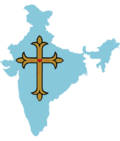This article includes a list of references, related reading, or external links, but its sources remain unclear because it lacks inline citations .(July 2019) |
Diocese of Punalur Dioecesis Punalurensis പുനലൂർ രൂപത | |
|---|---|
 St Mary's Cathedral in Punalur | |
| Location | |
| Country | India |
| Ecclesiastical province | Trivandrum |
| Metropolitan | Trivandrum |
| Statistics | |
| Area | 5,052 km2 (1,951 sq mi) |
Population
|
|
| Parishes | 41 |
| Information | |
| Denomination | Roman Catholic |
| Sui iuris church | Latin Church |
| Rite | Roman Rite |
| Archdiocese | Roman Catholic Archdiocese of Trivandrum |
| Cathedral | St. Mary's Cathedral, Punalur |
| Patron saint | St Thérèse of Lisieux |
| Current leadership | |
| Pope | Leo XIV |
| Bishop | Selvister Ponnumuthan |
| Metropolitan Archbishop | Thomas J. Netto |
| Vicar General | Vincent D’Cruz |
| Episcopal Vicars | Johnson Joseph, Jude Thaddeus Ambattur |
| Website | |
| Website of the Diocese http://www.dioceseofpunalur.com/ | |
The Roman Catholic Diocese of Punalur (Latin : Punaluren(sis)) is a diocese located in the city of Punalur in the ecclesiastical province of Trivandrum in India.
